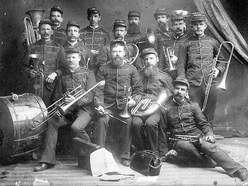By Jayan Nandagopan There are many factors that lead to the evolution of the contemporary brass quintet. When considering the repertoire, one must first start at the beginning with chamber music, then, explore how the development of new instruments and styles over the ages influenced the art. Considering these points it is possible to see the intricacies and multilayered progressions that have come together to form the modern brass quintet. CHAMBER MUSIC Chamber music is traditionally intended to be performed in a smaller, private room or concert hall by an ensemble with one player per part. This differs from orchestral and operatic music, designed for large concert halls and theaters with many players playing the same part. Chamber groups contain a small number of musicians whereas orchestras can contain fifty plus. Chamber music holds its roots in the middle ages and early renaissance, where small groups were used mostly to accompany singers. It then progressed through the Baroque period, concentrating on counterpoint, most notably J.S. Bach. Counterpoint is creating a melody and then getting different instruments to start the melody at different times, creating a complex tapestry of sound. A popular example of this is Pachelbel’s “Canon” used for weddings and many ceremonies still today. The exact instrumentation of the Chamber ensemble had yet to be defined. Pieces were written for a keyboard instrument, such as a harpsichord, but also were playable by a variety of string and wind ensembles. Interestingly the baroque keyboard accompaniment was written using “figured bass”, a composition technique similar to the chord symbols above music or lyrics today. The latter part of the 18th Century saw the favoring of the “gallant” style. This style used clearly defined melodies and bass lines differing from the more complex counterpoint. A new custom that became popular was to get street musicians to play concerts in the evenings below patrons’ balconies. Thus a new style of chamber music was born: the serenade (sera-night). Composers were commissioned to write pieces for these small ensembles of four to six musicians. This all leads us to Joseph Haydn and the Classical period. Haydn is widely credited with forming the modern Chamber ensemble. He wrote extensively for a variety of string and piano ensembles, developing a style that would be used for the next two hundred years. Using this standard form for quartet and chamber music composition, another composer vastly expanded the repertoire and the different combinations of instruments used. Wolfgang Amadeus Mozart, one of the great masters of the Classical period, included different instruments, like the newly invented clarinet, into Chamber music. He wrote quartets for flutes and other winds, combining new orchestrations that opened chamber music up to new timbres and nuances. Chamber music then moved out of people’s homes and into the concert hall. The fall of the aristocratic system, the improvements to string instruments and the invention of the pianoforte all contributed to the shift. Professional musicians now were paid to play for the public on louder instruments designed for larger halls. Ludwig van Beethoven was the master who took this change and created some of the greatest works ever written for chamber ensembles, leading the world from Classicism to Romanticism and beyond. Other notable composers of the Romantic period were Schubert and Mendelssohn. Mendelssohn’s most famous work is the “Wedding March”. The change in ideals throughout the 19th century brought with it the change in chamber music. Chamber music of this period was to be played as much as it was to be listened to. Many amateur ensembles were formed and thousands of pieces were written for a variety of ensembles. Piano and symphonic music caused composers like Wagner, Liszt and Chopin to break away from chamber music to follow their ideals of “pure music”; they had thought that the musical style of Beethoven had run its course. On the opposite side of this break called “The War of the Romantics”, was Johannes Brahms. Ironically, one of the pieces most played by chamber groups today is an arrangement of Wagner’s “Bridal Chorus” (Here comes the Bride). Wagner was also responsible for creating new and innovative brass instruments. He used very large brass sections in his orchestral works and also composed pieces completely for wind instruments. Holst, Stravinsky and Berlioz were also writing for this wind ensemble creating a crossover from orchestral music to the Concert/Wind band. BRASS IN CONCERT BANDS Concert bands date back to just before the American Civil War with a number of professional ensembles. Most notably was Gilmore's Grand Boston Band that began what is known as the "Golden age of Bands". Very large bands, some with one hundred players, made up of brass, woodwind and percussion would play at paid events to entertain with waltzes, polkas and marches. They were rehearsed and professional entertainers and became very popular. During the Civil War, Gilmore's band was enlisted in a volunteer regiment and became the standard for future military bands. After the Civil War, Gilmore's Band toured Europe to a rave response, further popularizing the style. Gilmore was the predecessor to the most popular and famous brass and wind band leader, composer and arranger, John Philip Sousa. In 1880 Sousa became the leader of the United States Marine Band. Sousa composed military and ceremonial music that is still the standard today. When you hear a brass band playing Star Spangled Banner, it is the Sousa arrangement that you will recognize. This was the peak of the "Golden Age of Bands" and as new forms of entertainment were sought after, the popularity of the wind band declined. One of the styles of music that emerged from New Orleans at this time would change the world forever. BRASS IN JAZZ Jazz has its roots in the southern States of America but truly flourished in the red light district of New Orleans on Basin Street. The musicians employed marching instruments that were quite cheap and available due to the disbanding of many military groups after the civil war. The first group thought to have invented "swing" was lead by a cornet player, Buddy Bolden. Buddy's group and another cornetist from Atlanta, W. C. Handy, paved the way from vaudeville and bordellos to international stardom and into the Jazz age. Louis "Satchmo" Armstrong was the most famous performer and innovator of the Jazz Age. He played the cornet and trumpet, further popularizing the instruments as many players wanted to imitate his unique sound. Jazz was being played in small groups, from five to seven members consisting of some soloists and a rhythm section. Jazz got a mixed reception from many people from the older generation as it was considered a pulling away from tradition and the church. Racism also played a large roll in Jazz's acceptance into the mainstream. In the mid to late 1920s the shift began from New Orleans style "hot" jazz to swing dance music played by larger, white orchestras. This began the Big Band era. Big Band music dominated the 1930s and lifted morale during World War II. A Big Band contained at least eight brass musicians, saxophones and a rhythm section. Names such as Benny Goodman, Glenn Miller, the Dorsey brothers and Duke Ellington were superstars of the era. By the end of the war, due to the loss of many personnel (including Glenn Miller), change of taste, and the increased popularity of bebop, many of these big bands broke up. Both jazz and classical music were becoming more interwoven with composers like Gershwin, and Broadway writers borrowing from both styles. BRASS QUINTETS AND MODERN MUSIC In the classical style, Brahms took romanticism and chamber music through the 20th century and into the impressionist era. Claude Debussy used new styles of composition to get a completely different color, leaving the listener in a wash of sound, an impression of the composer’s emotion and subject. From here musical freedoms and avant garde composers shifted into many different modern and post modernist styles. These manipulated Serialism, polytonality, and polyrhythms to create a wholly different approach to chamber music. With the huge legacy of chamber music repertoire and some virtuosic symphonic musicians, the brass quintet was formed. The first contemporary brass quintets, The Chicago Brass Quintet and The New York Brass Quintet, were formed in the 1940s. The Chicago Brass Quintet had two members that would help shape brass quintets around the world, Arnold Jacobs on tuba, and Renold Schilke on trumpet. They taught and mentored some of the players of the most famous brass quintet in the world, The Canadian Brass. Most of the new repertoire and works transcribed for brass were premiered by the Canadian Brass. They also played many jazz arrangements and moved later into pop. Although the Canadian Brass popularized brass quintets, there were other significant groups that have contributed to the style. The American Brass Quintet are champions of new music and have commissioned many works for brass quintet. There are also some top tier artists worth mentioning like Empire Brass, but of course the list goes on. In the last thirty years, brass quintets around the world have become popular and many fine groups have been formed. Thus the repertoire that has its base all the way back to the Renaissance, has grown and is still growing into the many thousands of pieces played today. Now, the brass quintet has the opportunity to play music of all styles including jazz, pop, classical and everything in between. New arrangements are being written and new works composed every day, so the imagination is the brass quintet's only limitation. This exciting and unique group of instruments has drawn virtuosic musicians, amateurs, composers and arrangers from every corner of the globe to be involved. Jayan Nandagopan B. Mus, Grad. Dip. Ed. Note: This is a very reduced and simplified version of the history of chamber and brass music. I hope it provided some small insight into the vast history of the Brass quintet and Chamber ensembles. I didn’t go into the development of the various separate brass instruments but I’ll leave you with some links if you are interested. Sources: Wikipedia.
1 Comment
|
Franco Finstad
Founder and leader of the Chamberlain Brass and freelance trumpet player in NYC. Archives
November 2021
Categories |

 RSS Feed
RSS Feed